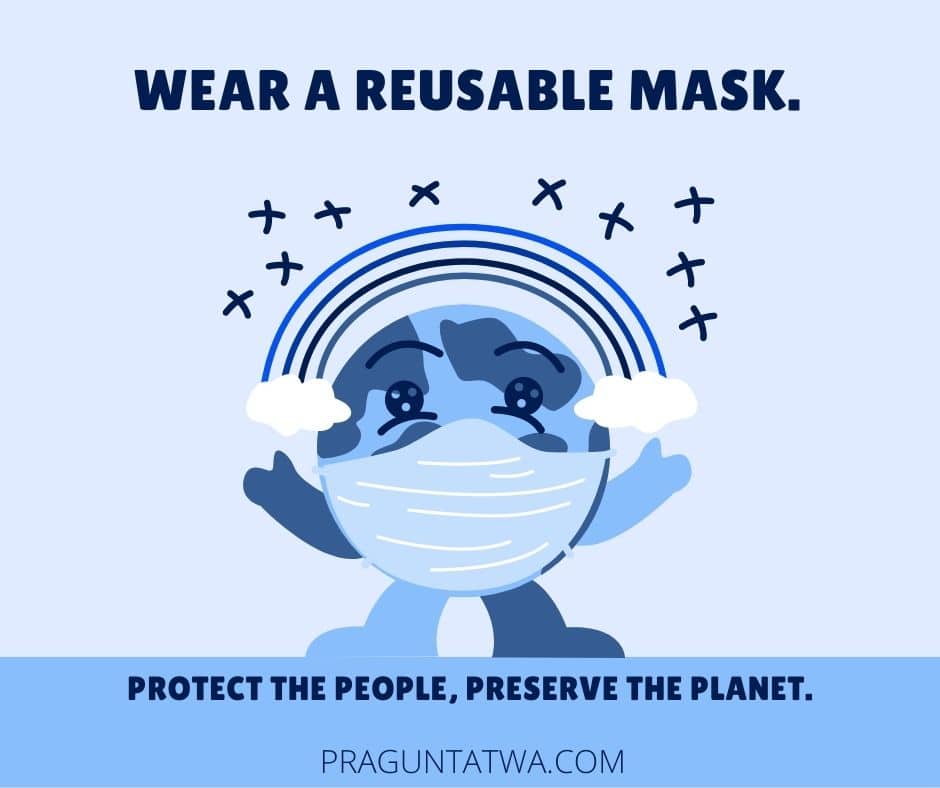How to properly dispose of face masks and protect the environment?

In recent times, wearing masks has become a global requirement to stop the spread of COVID-19. Masks are an effective way of preventing the spread of the infection of novel coronavirus and they have become an everyday accessory. But, they are proving disastrous for the environment. They have a drawback because polypropylene can break into microplastics that take between 400 and 450 years to break down. So, with this new type of environmental pollution, The question that arises is: What about the safe way to dispose of masks?
Impact on environment
Due to the Covid-19 pandemic, with billions of people globally using masks every day, we are facing a new kind of environmental concern. The use of disposable face masks has been adopted worldwide as a precautionary measure to slow down the transmission of the virus. Don’t forget it’s not just the use of a mask that is important but it’s equally important to use it properly. Face masks are a very important component to save us from catching an infection. However, have you ever thought, what are the effects of the huge increase in the use of disposable masks? Well, the environment is in danger of being another victim if we do not dispose of the masks carefully.
Disposable face masks could be releasing chemical pollutants and nano-plastics into the environment, that if eaten by wildlife can block their digestive tracts. “Before the pandemic, we were looking at reducing the use of plastic straws, reducing packaging, but now we are looking at hundreds and thousands of these masks being disposed of,” said the project leader, Dr. Sarper Sarp, of the university’s College of Engineering. Traces of lead, antimony, and cadmium – all heavy metals which can be toxic in low doses are also found in various tests done on face masks.
Types of masks
The masks commonly in use are cloth masks, 3 layered surgical masks, and N95 respirators.
- Cloth masks – Although, they are not ideally recommended when taking care of infected patients. They do not provide adequate protection but they are still better for routine use than not covering your mouth and nose. However, if a face mask is not available, you can at least use a bandana, dupatta, or a scarf to cover the face.
- Surgical mask – These are loose-fitting, disposable devices made of polypropylene. These may be effective in blocking particle droplets, splashes, and sprays that may contain germs, keeping them from reaching the mouth and nose. Ideally used by persons caring for sick persons with respiratory infections and symptoms such as cough, sneezing, and fever, and health care and frontline workers.
- N95 respirator – Not for routine use for the general public. It’s made of polypropylene material. These respirators filter out at least 95% of very small (0.3 microns) particles. These respirator masks are capable of trapping 95%, 99%, and 99.9% of particles, smaller up to 0.3 microns in size.
with inputs from google
How to dispose of masks correctly
Different germs can survive on a used mask for different durations. The study says that viruses, when left exposed, can survive between a few hours and a few days. Being eco-conscious I request you not to throw the used mask indiscriminately in open spaces, parks, workplaces, lifts, and open dust bins as it can pose a potential health hazard to people who come in contact with such masks. Also, some people are picking them up for re-use and hence putting their life in danger. The infected masks have respiratory secretions on them, that can disperse and transmit through the air. So, please be careful, and always wash your hands before and after taking off the mask.
- Cloth mask – Wash properly and frequently and hang to air dry.
- Surgical mask – Fold, tie, and wrap are the best ways to dispose of these masks. Please take care to remove it from the strings. Be careful not to touch the front portion while taking off the mask. After taking the mask off, please fold it half inwards, such that you don’t expose droplets from the mouth and nose. Then, fold the mask into another half, until it looks like a roll. One can also wrap the mask with its ear loops so that it will not unravel. Then wrap the mask in a tissue paper or polythene bag and immediately discard it in the yellow waste bag. Keep the things handy before disposing of it them.
- N95 respirator – When removing the mask, hold the edge of the straps attached to take off the N95 mask. Don’t touch the inside part of the respirator. Gently remove the mask so as not to disseminate contaminants on the mask. Place the mask in a plastic bag or zip-lock bag. You can also store them in a breathable container such as a paper bag between uses. Secure the bag tightly. Place the plastic bag into a garbage can or biomedical waste disposal unit. Never put on a new mask until you have properly washed your hands. Wash hands before and after it.

Mask is a must, but don’t throw it in a just
The health department has already issued the guidelines that one must discard and collect used masks FROM COVID-19 Isolation Wards / Test Centres and Laboratories (including triple layer masks, N95 masks, etc) in separate ‘yellow color-coded plastic bags’ (suitable for biomedical waste collection). For Quarantined homes or other households: Used masks should be kept in a paper bag for a minimum of 72 hours prior to their disposal as general waste. This must be done in accordance with the Solid Waste Management Rules, 2016. It is also advised to cut the masks prior to disposal to prevent their reuse. In recent months, when the pandemic surged, disposable masks that had not been disposed of correctly have been turning up in cities around the world. Environmentalists have warned that this residue is a threat to human life marine life and wildlife habitats. Although alternatives are appearing, we need to be more careful with the usage and disposal of masks.
The World Health Organisation (WHO) recommends discarding them in the “correct” rubbish bin immediately after use and not reusing them. Do not dispose of masks and other disposable materials that contain the virus-related material, such as gloves, masks, and PPE kits in the recycling bin with packaging, cans, etc., or with organic waste. Do not throw them away with your general household rubbish.
To sum up, This is my conscious lifestyle post to spread more awareness about sustainable living. and Join me for more such ways and tips and become part of my Conscious and sustainable living journey. Keep visiting my blog to make yourself eco-friendly, aware of conscious and sustainable choices and be more concerned for our environment, and alter your lifestyle.
Being Eco-Friendly is not a choice, make it a habit.
To add on, Read and listen to my Green talks series and check out interviews with Eco-conscious people who are trying their bit towards conscious and sustainable living practices. There is so much to learn and explore from all of them I had interacted with, do listen and drop in your views in the comments. Check here to know more about all the Eco-Friendly dates








Recent Comments